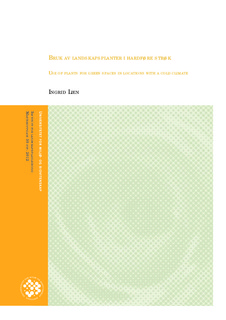| dc.description.abstract | I hardføre deler av landet benyttes ofte et begrenset utvalg landskapsplanter i grøntanlegg, i forhold til hva som er tilfellet i klimamessig mer gunstige områder. Dette beror naturlig nok på det harde klimaet, som gir begrensninger for plantevekst. Planteutvalget omfatter arter som man med stor grad av sikkerhet vet vil kunne overleve, noe som gir lite mangfold og variasjon. Tross det harde klimaet, finnes det et større utvalg planter som kan benyttes, og som vil kunne gi et større mangfold?
Denne oppgaven ser på muligheter for en mer utbredt bruk av landskapsplanter i hardføre deler av landet, for økt mangfold og variasjon. Bruk av et større utvalg arter, og hvordan plantene kan benyttes vil være sentralt. Oppgaven består av en teoridel, datainnsamlingsdel og en del med eksempel på bruk av landskapsplanter i hardføre strøk.
Teoridelen tar for seg flere temaer. Vegetasjonens mange verdier og kvaliteter, både de visuelle og de ikke-visuelle, argumenterer for en mer utbredt bruk av vegetasjon. I denne delen av oppgaven gis også en innføring i hva som styrer plantenes herdighet, hvordan man kan tilrettelegge for å bedre vokseforholdene, samt vegetasjonsbruk.
Datainnsamlingsdelen omfatter egne vegetasjons-registreringer, samt innhentet materiale fra sortslister. Denne delen utgjør en stor del av oppgavens kunnskapsgrunnlag, hvor datainnsamlingen gir grunnlag for en sortsliste med landskapsplanter for hardføre strøk. Gjennom denne delen av oppgaven kommer det frem at det finnes et godt utvalg potensielle landskapsplanter til bruk i hardføre strøk.
Den siste delen baseres på innhentet kunnskap fra teoridelen, samt den endelige sortslista fra datainnsamlingsdelen. I denne delen av oppgaven vises et eksempel på bruk av landskapsplanter for hardføre strøk. Bruken av vegetasjon og vegetasjonselementene i dette anlegget er ment å være til inspirasjon for andre planteinteresserte og overførbart ved utforming av alminnelige grøntanlegg i hardføre strøk. Anlegget er slik sett tenkt å fungere som et demonstrasjonsanlegg.
Oppgaven viser at det er muligheter for en økt bruk av landskapsplanter i hardføre strøk. Dette bekreftes spesielt gjennom datainnsamlingen, som gir grunnlag for en sortsliste med et godt utvalg potensielle arter. I oppgaven synliggjøres også hvordan man ved bruk av plantene kan oppnå større mangfold og variasjon i grøntanlegg i hardføre strøk.
On locations with a cold climate the range of landscape plants used in green spaces is often limited compared to locations where the climate is more favorable. This as a natural result of the harsh climate, which limits the growth. The range of plants includes species that with great certainty are known to survive, which gives little diversity and variation. Despite the cold climate conditions, are there a larger range of plants available for usage, and could they make a greater diversity?
This master thesis explores the possibilities for a more widespread use of plants for green spaces on locations with a cold climate, to achieve increased diversity and variation. The use of a larger selection of species, and how the plants can be used will be a central theme. The thesis consists of a theory section, a collection of data and a final section which demonstrates the use of plants for green spaces on locations with a cold climate.
The theory section deals with several themes. The many values and qualities of vegetation, both visual and non-visual, speak for a more widespread use of vegetation. This part of the thesis will also provide a general introduction to what is controlling the hardiness of the plants, how to facilitate for improved growing conditions, and the use of vegetation.
The data collection includes records of vegetation obtained by the author, and collected material from lists of species. This part is a large piece of the knowledge in the thesis, in which the data collection gives a base for a list of species containing plants for green spaces suited for locations with a cold climate.
The final part is based on acquired knowledge from the theory part, as well as the final list of species from the data collection part. In this section of the thesis an example of the use of plants for green spaces on locations with a cold climate will be provided. The use of vegetation and vegetation elements in this particular green space is supposed to be an inspiration for other plant enthusiasts and also to be transferable in the design of ordinary green spaces on places with a cold climate. This green space is in this order supposed to function as a demonstrational park.
The thesis enlightens the possibilities of a wider use of plants for green spaces on locations with a cold climate. This is confirmed through the data collection, which gives basis for a list of species that contains a wide selection of potential species. The thesis also visualizes the opportunities of increased diversity and variety in green spaces on cold climate locations, through the use of these plants. | no_NO |
